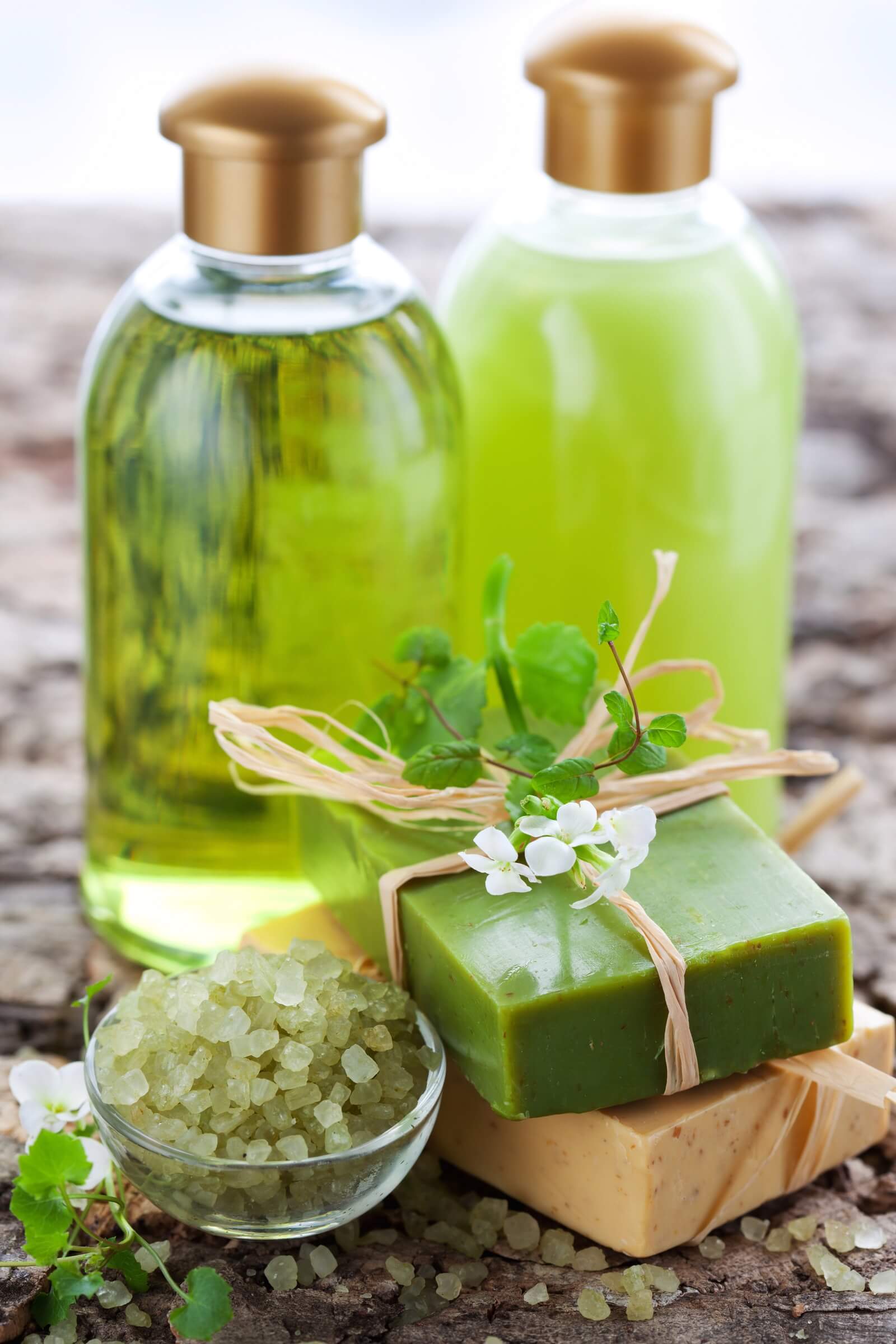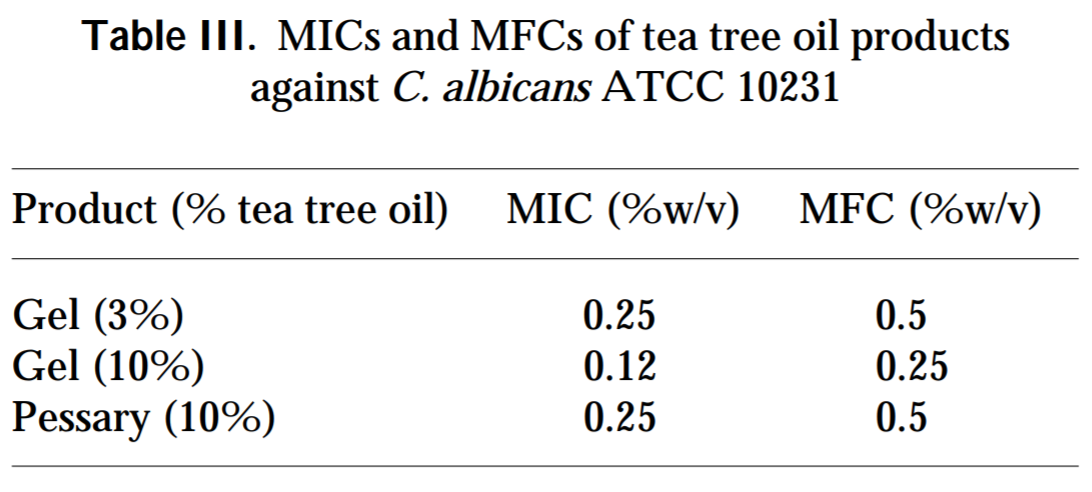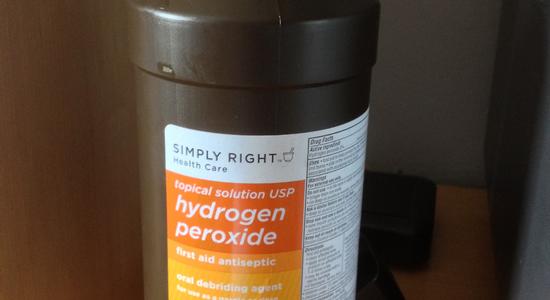See all "Tampons" Section Topics

Can using a tampon soaked in tea tree oil get rid of a vaginal yeast infection? The answer is, it certainly can. Although, this may not be the quickest way to remedy this condition. Yet, tampons can make a great carrier for tea tree oil. And, using a tampon soaked in this essential oil intermittently throughout the week, may clear up a yeast infection faster than prescription or over-the-counter drugs. Additionally, the cost of using tea tree oil should be far less than expensive over-the-counter or prescription antifungal drugs.
Perhaps the primary concern, when using tea tree oil, is safety. Topically applying 100% tea tree oil on insensitive skin should pose little to no danger. The exception would be if you are allergic to the oil. Concerning intra-vaginal use of tea tree oil, you will want to dilute the oil. As research suggests, a 5% concentration of tea tree oil should be sufficient to kill Candida.
To be safe, you may want to perform a patch test with the concentration of tea tree oil you intend to use with the tampon. Simply take the diluted essential oil and place a small amount on the surface of your arm. After some time has passed, you will see if your skin reacts adversely to the essential oil. This is a practical way to help better determine if you have any allergic reactions to an essential oil in a safe manner.
Make sure you never ingest tea tree oil, it is highly toxic and can cause death to occur if enough is swallowed. According to the late Dr. James Duke, formerly one of the world&s best experts on medicinal plants, drinking tea tree oil is highly dangerous. Dr. Duke, in his book The Green Pharmacy, states that just a few teaspoons of the oil—if ingested—can prove fatal. He also cautions that tea tree oil is such a powerful antiseptic that you may want to use it in the vaginal area in a diluted form and only as a last resort. Dr. Duke suggests trying other, more gentle herbal approaches, first before using this essential oil.
Jeffery Aronson, in his book Meyler’s Side Effects of Drugs, also states some warnings about using tea tree oil. According to Aronson, ingesting a half teaspoon of the oil can cause a dramatic rash to occur. The book also states that ingesting a half teacup can cause a coma; followed by a state of semi-consciousness with hallucinations. Arnonson also cites a retrospective review of patch test data over 4.5 years. Out of 2320 people given a patch test, 41 people had reactions to oxidized tea tree oil (when there is more air than essential oil in a bottle, the oxidation rate increases; storage protocol affects oxidation rate); giving a prevalence of 1.8%. It should be noted Aronson also states most reactions occur when using aged tea tree oil; individuals who are allergic to tea tree oil do not have skin reactions with freshly distilled tea tree oil.
Due to tea tree oil’s potency and toxicity, you should never use it with small children.
Candida Hub has a whole section dedicated to tea tree oil. If you’d like more information on how tea tree oil can cure a yeast infection, you can check out Naturally Eliminating a Yeast Infection with Tea Tree Oil.
A 1/2 Day & Yeast is Gone!
Linda Allen suffered from yeast infections for years. Through researching natural medicine & Candida, she found an efficacious solution!
Linda is one expert you want on your side! Let her show you how to get rid of a superficial yeast infection in just 12 hours; AND, keep it gone!
A 60-day, 100% money back guarantee is provided.
Visit Official Site!Tea Tree Oil’s Candida Fighting Ability

An excellent study we will examine was published in The Journal of Antimicrobial Chemotherapy [42.5 (1998): 591-595]. The study examined the in-vitro ability of tea tree oil, and tea tree oil products, to inhibit Candida. Particularly of note, is that the products examined by this research, were intra-vaginal products containing tea tree oil. Thus, the research gives us a good idea about the safety and efficacy of intravaginal tea tree oil use. Additionally, the study tested tea tree oil on 81 C. albicans strains and 33 non-albicans strains of Candida. Thus, the research was quite thorough in its examination of Candida in this regard.
Concerning the chemical composition of the tea tree essential oil utilized by the research, it contained 37.1% terpinen-4-ol and 3.2% 1,8-cineole; these findings were determined by gas chromatography-mass spectrometry. The intravaginal products were supplied by a provider.
The study found that a 10% tea tree oil intra-vaginal gel had a minimum inhibitory concentration (MIC; the smallest amount of a substance that will stop the growth of an organism) of 0.12% weight / volume. A 10% tea tree oil vaginal pessary (a pessary is a vaginal suppository) had an MIC of 0.25% weight / volume. Concerning the minimum fungicidal concentrations (MFC; the smallest amount that will actually kill a fungus) for these products; the 10% tea tree oil gel had an MFC of 0.25% weight / volume, and the pessary had an MFC of 0.5% weight / volume. Thus, these findings indicate that a small amount of these products is sufficient to kill Candida. A chart showing this data, taken from the study, is presented below.

Concerning regular tea tree oil, the study found the MIC90 for 81 C. albicans strains (which was the concentration of the oil that inhibited 90% of the cells) was 0.25% volume / volume. The MFC90 for 81 C. albicans strains (which was the concentration of oil that killed 90% of the cells) of tea tree oil was 0.25% volume / volume. This again shows the excellent efficacy of tea tree oil as a Candida fighting agent. The following quotation was taken from the study’s abstract:
Tests on three intra-vaginal tea tree oil products showed these products to have MICs and minimum fungicidal concentrations comparable to those of non-formulated tea tree oil, indicating that the tea tree oil contained in these products has retained its anticandidal activity. These data indicate that some essential oils are active against Candida spp. [spp. is an abbreviation for species], suggesting that they may be useful in the topical treatment of superficial candida infections.
The Journal of Antimicrobial Chemotherapy [42.5 (1998): 591-595]
Perhaps one of the best research papers, on the topic of tampon use with this essential oil, was published in Obstetrics and Gynecology [vol. 19 (1962): 793-5]. The study’s stated purpose was to determine the safety of tea tree oil in its use as a topical treatment for Trichomoniasis and vaginal yeast infections. The essential oil’s use as a douche was also evaluated. Other reasons this research was conducted was to determine any possible side effects of using this essential oil, and to ascertain how to use the oil in terms of safety and efficacy.
The study used 40% tea tree oil emulsified with 13% isopropyl alcohol (rubbing alcohol) as the medication. The emulsion was miscible (forming a homogeneous mixture when combined) in water, and somewhat milky in appearance when diluted.
The study utilized 10 patients who had cervicitis. They were given tampons saturated in this tea tree oil medication; the tampons were made with three 4 X 4 inch sponges, and were left in the women’s vaginas for 24 hours. The vagina, perineum (the area between the vulva and the anus), and labia were washed and allowed to dry. Next, the vaginal canals of these women were washed with the 40% tea tree oil medication mixture.
The study reported, after this treatment was undertaken, that the cervicitis was cured and healed after 4 weekly treatments. The tea tree oil medication did not irritate the vaginal mucosa (mucus membranes; i.e., the outer layer of vaginal tissue that secretes mucus); it only had a mildly drying effect.
In the study’s summary it is stated that tea tree oil, in suitable dilutions, was found to be a "highly effective" treatment for vaginal yeast infections. The study found that a 40% dilution of tea tree oil produced no irritation, burning, or other side effects when used. The study also stated that daily vaginal douches of 0.4% tea tree oil were safe and effective for the various vaginal infections analyzed (which includes yeast infections).
Eliminate Bacterial Vaginosis & Vaginal Odor
Jennifer O’Brien is one prominent expert on BV that knows how to get rid of vaginal odor. BV is a common infection that you don’t have to put up with.
Jennifer will show you how to naturally eliminate vaginal odor in just 3 days.
A 60-day, 100% money back guarantee is provided.
Visit Official Site!Literature About Using Tea Tree Oil for Candida

The late, and renowned, Dr. James Duke discusses using tea tree oil in his book The Green Pharmacy Herbal Handbook. According to Dr. Duke, tea tree oil can be used to treat yeast infections and vaginitis. Concerning dosage, Dr. Duke suggests for topical use (possibly not intravaginal) to use undiluted tea tree oil; but, cautions that it may cause irritation. Dr. Duke suggests starting off with a diluted concentration of the oil just in case you may be allergic to it. And, Dr. Duke states that you should not ingest tea tree oil.
David Rakel, in his book Integrative Medicine, suggests using tea tree oil for treating yeast infections. Rakel states that tea tree oil has shown antifungal efficacy in in-vitro studies; the ability of this oil was similar to those of the antifungal drugs miconazole (the drug in Monistat), econazole, and ketoconazole (Nizoral). It was also found good at stopping fluconazole resistant Candida strains in in-vitro studies.
Rakel states that recurrent vaginal yeast infections are often difficult to cure; and, may require more than just conventional therapy to resolve. Concerning tea tree oil, Rakel suggests in his book, to utilize a 5% to 10% concentration topically if you are not allergic to the oil.
Marc Micozzi and Tieraona Dog, in their book Women’s Health in Complementary and Integrative Medicine E-Book: A Clinical Guide, state that tea tree oil is an effective Candida fighter. The authors state that research has demonstrated the oil possesses considerable antifungal and antibacterial ability. Tea tree oil has been shown to be able to fight many different species of Candida; including itraconazole and fluconazole resistant strains. The book states that fluconazole resistant strains of Candida are about as susceptible to this essential oil as fluconazole susceptible strains.
Clair Goodall: Author & Nature Lover
Clair Goodall is a bee-obsessed natural medicine convert from Minnesota. She is one expert you might want to know more about!
Clair will help you protect you and your family from toxic products and chemicals and help you discover solutions from nature.
Also, Clair’s book is backed by a 60-day, 100% money back guarantee
Visit Official Site!How to Make a Tea Tree Oil Tampon

Concentration: It would be wise to follow the Obstetrics and Gynecology [vol. 19 (1962): 793-5] study when it comes to the concentration of tea tree oil you will use. The study used a 40% concentration of tea tree oil with their tampons, and no adverse effects were reported at this concentration. However, it may be quite effective to just use a 5% concentration for added safety; as tea tree oil is a somewhat powerful substance. As research has indicated, 5% concentrations of tea tree oil should be more than enough to effectively kill Candida.
Carrier Oil: Using a carrier oil that also has proven ability to inhibit Candida may be a great choice. One oil that effectively inhibits Candida is coconut oil (you can learn more about using this oil in Candida Hub’s article Coconut Oil for Yeast Infections). Coconut oil has a melting point of 78°F and may be able to adequately liquify in the vagina. Additionally, coconut oil will be solid at room temperature; allowing you to heat the oil, mix in the tea tree oil component, and store with more ease. But, you do not have to use coconut oil!
Tampon Use: As the research indicates, leaving this tea tree oil tampon in for 24 hours should pose little to no hazard. However, if you feel discomfort you should discontinue use. You may want to avoid a 40% tea tree oil concentration at first, and start off with 5%. If you feel no discomfort, it may be safe to increase the concentration. As the Obstetrics and Gynecology [vol. 19 (1962): 793-5] study pointed out, the tea tree oil tampons were used once a week for 4 weeks. Try starting out using the oil soaked tampon every other day for 12 hours; if you experience no discomfort, you can then try increasing the duration and frequency of use.
An Additional Tampon Suggestion
Cynthia Olsen, in her book Australian Tea Tree Oil First Aid Handbook, states vaginitis is often caused by Candida. As a remedy for this, she also suggests using a tampon and putting this oil on it. According to Olsen, a woman should douche with 8 to 10 drops of tea tree oil mixed with 1 pint of purified water. This treatment can be undertaken daily until your symptoms are gone. Olsen suggests, between douching, to saturate a tampon with several drops of tea tree oil. Next, insert the tampon and leave it in for 24 hours. Olsen states that a light sensation may be felt.
Also, Olsen suggests adding 10 drops of tea tree oil to a tub of warm water and soaking for 20 minutes. It may be best not to use a full tub; making a sitz bath could be more effective. A sitz bath is made by filling a bathtub with enough water to cover the genital area, but no more water than this. By reducing the amount of water, of course, you allow for a stronger concentration of therapeutic products. You can also consider adding other Candida fighting essential oils to the sitz bath as well. Sitz baths may be best; as the water will dilute the oils significantly.
In-Vivo vs. In-Vitro

As with many natural remedies, there is often a great lack of official research efforts made to officially verify the efficacy of these treatments. Prescription antifungal drugs often get a lot of attention; and, there is probably a lot of money made available for such research efforts. Large pharmaceutical companies need studies to sell their products on a grand scale. It is unfortunate, but little, if any, journal papers are published on the in-vivo (in a living patient) ability of natural remedies. You simply cannot patent an herb or essential oil. Because you can sell Monistat to women over the counter, there is probably more than enough research on in-vivo application of miconazole (the synthetic drug which is the active ingredient in Monistat).
As a result of the lack of official scientific studies, some argue that an herb or essential oil is totally incapable and dangerous. Often, when a purported "expert" makes a claim against a natural remedy they will hail the fact there are no in-vivo studies to verify a remedy’s efficacy. This appears to be done in an effort to somehow make their statements against the remedies pure truth. Yet, that would take a study to effectively disprove the efficacy; not a lack of official studies.
It is highly unwise to suggest a remedy that works in-vitro does not work in-vivo. The fact is, if you use rubbing alcohol on your skin, it will disinfect an area. Regular drinking alcohol will also disinfect the area it is applied to. Tobacco use will addict you to using this plant. An official scientific, costly study is not required to determine this.
For example, people have known the medicinal power of drinking alcohol for millenia; we do not need a scientific journal to verify the obvious before we make use of, or claim to know, it is an effective antimicrobial agent. Yet, negative claims garner a lot of press and attention. People are more than ready (and possibly very scared), when some random expert states a natural remedy does not work, to listen. Yet, if they claim to only do what scientific journals prove; why are they so alacritous to denounce a natural therapy when the very same journals never report a study disproving the ability of the natural remedy they argue against?
A Natural, 12 Hour Yeast Infection Cure

Many men and women suffer from yeast infections; yet, this problem can be even more devastating when you keep getting yeast infections. If this isn’t your first yeast infection; and, it hasn’t been a long time since your last one; you may have excess yeast in your body that is causing the recurrent outbreaks.
One woman who suffered from recurrent yeast infections was Linda Allen. Linda, in the past, had a bigger problem than just outward infections, she was plagued with systemic Candidiasis. Linda spent about 12 years suffering from the misery that "yeast syndrome," i.e., systemic Candidiasis, can bring about.
Linda’s health problems with Candida came to her attention when she developed a yeast infection. Like many, she went to the doctor for a solution; and, the doctor provided her with some medication. After using the drug, Linda found that her yeast infection cleared up; and was gone after she used the drug. Yet, it wasn’t long before Linda developed another yeast infection. This cycle of yeast infection outbreak and resolution would go on without a solution in sight. In addition to outward yeast infections, Linda’s health had severely declined. The many effects of systemic Candidiasis were taxing her health. The doctors simply did not know what to do; they even tried putting her on allergy medication. Nothing seemed to work; Linda did not know why her health was in such disarray.
Things changed one day when Linda visited a naturopathic practitioner. The naturopath knew exactly what was causing Linda’s recurrent yeast infections and ill health: systemic Candidiasis. Although the naturopath did not provide Linda with a permanent cure to her systemic Candida problem, they did put her on the right path by elucidating the source of her terrible health.
Knowing her opponent, Linda then started diligently investigating Candida and natural medicine. It would take her some time; and she would try many different purported solutions; however, Linda finally developed a novel approach to treating systemic Candidiasis. Linda would go on, after she formulated her treatment system, to polish her new approach for about a year before trying it on herself.
When Linda tried her new system, she found her yeast infections stopped happening. In time, her health began to dramatically improve. Eventually, Linda knew she had cured her systemic Candidiasis. Linda took her new treatment system to a medical doctor and the doctor suggested letting others try out her new protocol. Linda did just that. And, as people started to use her system, they were seeing the same excellent results that she did. Linda’s treatment plan was repeatable and easily put into practice by those who gave it a try.
Linda went on to write a book documenting her natural treatment system. Since publishing her book, over 100,000 people from around the world have used her treatment plan successfully. With Linda’s natural medicine expertise, her book will show you exactly how to permanently stop recurrent yeast infections and allow you to recover from systemic Candidiasis. And, Linda also outlines a novel, 12 hour cure for yeast infections. Using Linda’s system, you can clear up a outward yeast infection in just 12 hours time.
Linda’s publisher is owned by the large U.S. based firm Keynetics Incorporated. Linda’s publisher is a large digital publisher, and offers her book in a downloadable format. If you are interested in reading Linda’s book, you will be able to download it immediately and read it on your smartphone, mobile device, or computer. Linda’s publisher also ensures your satisfaction by providing a 60 day, 100% money back guarantee on Linda’s book. If you decide to try Linda’s book, and you find it unsatisfactory for some reason, you can get a full refund of your money within 60 days of purchasing it. And, when it will only take you about half a day to clear up a yeast infection, this will provide you with more than enough time to verify the efficacy of Linda’s natural system.
To learn more about Linda’s personal story, see responses of those who gave her book a try, or to find out more about her book; you can get more information at Linda Allen’s website.
Author: Mr. Nicholas Gross

Nick Gross is a natural medicine enthusiast who has been researching and writing about natural medicine since 2008. Nick is primarily a web developer but also researches and authors written and video content about natural health. Nick has a bachelor’s degree in Management Information Systems from the University of Northern Iowa.
Disclaimer
The information on this website is not a prescription for anyone. This information is for informational or educational purposes only, and is not a substitute for professional medical advice or consultations with healthcare professionals.
Affiliate Disclosure
Some of the links provided on this website are affiliate links. When a purchase is made through these links, Candida Hub earns money from commission. This helps to keep the website up and helpful to people for free. Thank you for any support!
Stay Up to Date
If you enjoyed this article, consider following / liking our Facebook page. This page is primarily utilized to alert followers of new articles that are put on Candida Hub. Candida related news is also discussed. While you are there, you can see what has been more recently added to Candida Hub.
SOURCES:
- Google Books — Aronson, Jeffrey K.. “Meyler's Side Effects of Drugs: The International Encyclopedia of Adverse Drug Reactions and Interactions.” Elsevier [2015]. ISBN: 9780444537164
- Google Books — Duke, James A.. “The Green Pharmacy: New Discoveries in Herbal Remedies for Common Diseases and Conditions from the World's Foremost Authority on Healing Herbs.” Rodale [1997]. ISBN: 9780875963167
- https://doi.org/10.1093/jac/42.5.591 — Hammer, Katherine A., Christine Frances Carson, and Thomas V. Riley. "In-vitro activity of essential oils, in particular Melaleuca alternifolia (tea tree) oil and tea tree oil products, against Candida spp." The Journal of Antimicrobial Chemotherapy [42.5 (1998): 591-595].
- https://pubmed.ncbi.nlm.nih.gov/14485044/ — PENA, E F. “Melaleuca alternifolia oil. Its use for trichomonal vaginitis and other vaginal infections.” Obstetrics and Gynecology [vol. 19 (1962): 793-5].
- Google Books — Duke, James A.. “The Green Pharmacy Herbal Handbook: Your Everyday Reference to the Best Herbs for Healing.” United States, St. Martin's Press [2002].
- Google Books — Rakel, David. “Integrative Medicine.” Elsevier Health Sciences [Jan 1, 2007]. ISBN: 9781416029540
- Google Books — Marc S. Micozzi, Tieraona Low Dog. “Women's Health in Complementary and Integrative Medicine E-Book: A Clinical Guide.” Elsevier Health Sciences [2004]. ISBN: 9780702035982
- Google Books — Olsen, Cynthia B.. “Australian Tea Tree Oil First Aid Handbook: 101 Plus Ways to Use Tea Tree Oil.” Lotus Press [1999]. ISBN: 9781890941024







